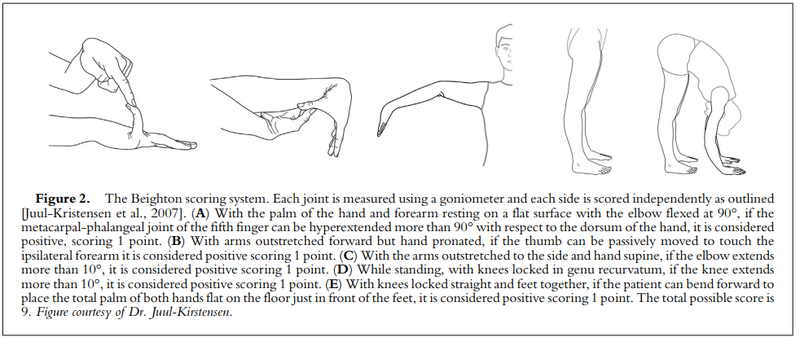Benign Joint Hypermobility Syndrome: Difference between revisions
mNo edit summary |
No edit summary |
||
| Line 1: | Line 1: | ||
{{Stub}}{{Nonmainstream}} | {{Stub}}{{Nonmainstream}}Benign Joint Hypermobility Syndrome (BJHS) is a condition that comes from the Rheumatology literature.<ref name=":0">Grahame R, Bird HA, Child A. The revised (Brighton 1998) criteria for the diagnosis of benign joint hypermobility syndrome (BJHS). J Rheumatol. 2000 Jul;27(7):1777-9. PMID: 10914867.</ref> It is thought by many to be the same condition as [[hypermobile Ehlers Danlos Syndrome]], a condition that comes from the Genetics and Paediatrics literature. | ||
== Hypermobility vs. Joint Hypermobility Syndrome == | |||
Hypermobility is fairly common. This is especially so in younger people, women, and in those with Asian and African descent. Most hypermobile people are asymptomatic and don't have an underlying connective tissue disorder. | |||
Joint hypermobility syndrome is a heritable connective tissue disorder that is characterised by chronic pain, musculoskeletal dysfunction such as dislocations, chronic fatigue, dysautonomia, amongst other problems. | |||
== Diagnosis == | == Diagnosis == | ||
The diagnosis is made with the Brighton criteria (not to be confused with the Beighton score) | The diagnosis of Benign Joint Hypermobility Syndrome (BJHS) is made with the 2000 Brighton criteria (not to be confused with the Beighton score).<ref name=":0" /> | ||
* Major Criteria | * Major Criteria | ||
Revision as of 21:51, 13 January 2022
Benign Joint Hypermobility Syndrome (BJHS) is a condition that comes from the Rheumatology literature.[1] It is thought by many to be the same condition as hypermobile Ehlers Danlos Syndrome, a condition that comes from the Genetics and Paediatrics literature.
Hypermobility vs. Joint Hypermobility Syndrome
Hypermobility is fairly common. This is especially so in younger people, women, and in those with Asian and African descent. Most hypermobile people are asymptomatic and don't have an underlying connective tissue disorder.
Joint hypermobility syndrome is a heritable connective tissue disorder that is characterised by chronic pain, musculoskeletal dysfunction such as dislocations, chronic fatigue, dysautonomia, amongst other problems.
Diagnosis
The diagnosis of Benign Joint Hypermobility Syndrome (BJHS) is made with the 2000 Brighton criteria (not to be confused with the Beighton score).[1]
- Major Criteria
- Beighton score of ≥ 4
- Arthalgia for longer than 3 months in 4 or more joints
- Minor Criteria
- Beighton score of 1, 2, or 3
- Arthalgia (> 3 month duration) in one to three joints or back pain (> 3 month duration) or spondylosis, spondylolysis/spondylolisthesis
- Dislocation or subluxation in more than one joint, or in one joint on more than one occasion
- Three or more soft tissue lesions (eg, epicondylitis, tenosynovitis, bursitis)
- Marfanoid habitus: tall, slim, arm span greater than height >1.03 ratio, upper segment less than lower segment <0.89 ratio, arachnodactyly
- Skin striae, hyperextensibility, thin skin, or abnormal scarring
- Ocular signs: drooping eyelids, myopia, antimongoloid slant
- Varicose veins, hernia, or uterine or rectal prolapse
- Mitral valve prolapse
- Requirements for diagnosis are any one of the following:
- Two major criteria
- One major plus two minor criteria
- Four minor criteria
- Two minor criteria and unequivocally affected first-degree relative in family history


